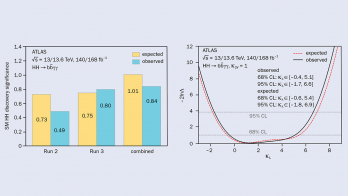The GERDA collaboration has obtained new strong limits for neutrinoless double beta decay, which tests if neutrinos are their own antiparticles.
The GERDA (GERmanium Detector Array) experiment, which is operated at the underground INFN Laboratori Nazionali del Gran Sasso, is looking for double beta decay processes in the germanium isotope 76Ge, both with and without the emission of neutrinos. For 76Ge, normal beta decay is energetically forbidden, but the simultaneous conversion of two neutrons with the emission of two neutrinos is possible. This has been measured by GERDA with unprecedented precision with a half-life of about 2 × 1021 years, making it one of the rarest decays ever observed. However, if neutrinos are Majorana particles, neutrinoless double beta decay should also occur, at an even lower rate. In this case, the antineutrino from one beta decay is absorbed as a neutrino by the second beta-decaying neutron, which is possible if the neutrino is its own antiparticle.
In GERDA germanium crystals are both source and detector. 76Ge has an abundance of about 8% in natural germanium and its fraction was therefore enriched more than 10-fold before the special detector crystals were grown. To help to minimize the backgrounds from environmental radioactivity, the GERDA detector crystals and the surrounding detector parts have been carefully selected and processed. In addition, the detectors are located in the centre of a huge vessel filled with extremely clean liquid argon, lined by ultrapure copper, which in turn is surrounded by a 10-m diameter tank filled with high purity water. Last, but not least, it is all located underground below 1400 m of rock. The combination of all of these techniques has made it possible to reduce the background to unprecedented levels.
Data taking started in autumn 2011 using eight detectors if 2 kg each. Subsequently, five additional detectors were commissioned. Until recently, the signal region was blinded and the researchers focused on the optimization of the data analysis procedures. The experiment has now completed its first phase, with 21 kg years of accumulated data. The analysis, in which all calibrations and cuts had been defined before the data in the signal region were processed, revealed no signal of neutrinoless double beta decay in 76Ge, which leads to the world’s best lower limit for the half-life of 2.1 × 1025 years. Combined with information from other experiments, this result rules out an earlier claim for a signal by others.
The next steps for GERDA will be to add new detectors, effectively doubling the amount of 76 Ge. Data taking will then continue in a second phase after some further improvements are implemented to achieve even stronger background suppression.
• GERDA is a European collaboration with scientists from 19 research institutes or universities in Germany, Italy, Russia, Switzerland, Poland and Belgium.








